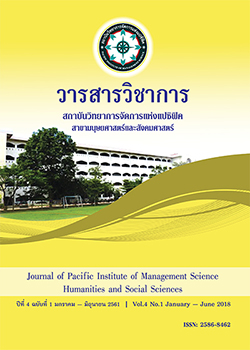Perception of Customer Experience in SME Spa’s Business Management
Keywords:
Perception of customer experience, Core service, Servicescap, Employee Behavior, Customer Satisfaction, Customer LoyaltAbstract
The Research aim to 1) Study the influence that effect Perception of customer experience in SME SPA’s business management 2) Study Perception of customer experience effect to customer satisfaction and customer loyalty. The research was conducted by qualitative and quantitative research. The qualitative research consisted with in-depth interview and focus group. The researcher determined population is SME SPA’s in Bangkok and number of samples are 400 samples from 50 administrative district that sampling of storage convenience. The research collect data using questionnaires between April to October 2015 and analyzed data by Structural Equation Model (SEM) analysis. The results show that the Core service, Servicescap, Employee Behavior have positive direct effect with Perception of customer experience. The Core service and Employee Behavior have positive direct effect with customer satisfaction. The Perception of customer experience have positive direct effect with customer satisfaction. The customer satisfaction have positive direct effect with customer loyalty. All of them according to the hypothesis.
References
สุภมาส อังศุโชติ, สมถวิล วิจิตรวรรณา และรัชนีกูล ภิญโญภานุวัฒน์. (2554). สถิติวิเคราะห์สำหรับการวิจัยทางสังคมศาสตร์และพฤติกรรมศาสตร์ : เทคนิคการใช้โปรแกรม LISREL. (พิมพ์ครั้งที่ 3). กรุงเทพฯ:เจริญดีมั่นคงการพิมพ์.
A.S.Sathis&RamakrishnanVenkatesakumar. (2011). Coffee Experience and Drivers of Satisfaction,Loyalty in a Coffee Outler-with special reference to Café coffee day. The JournalContemporary Management research. Vol.5 No.2. pp.1-13.
Bernd Schmitt. (1999). Experiential Marketing. Journal of Marketing Management.
Bedman N.&John K. (2014).Customer Satisfaction with Retails Banking Service in Guhana. Thunderbird International Business Review. Vol. 56, No. 4.,pp.353-371.
Bitner. (1992).Servicescapes: the impact of physical surroundings on customers and employees. Journal of Marketing. Vol. 56, April. pp. 57-71.
Bart Lariviere et al. (2016). Modeling Heterogeneity in the Satisfaction, Loyalty Intention, and Shareholder Value Linkage: A Cross-Industry Analysis at the Customer and Firm Levels.Journal of Marketing Research. Vol LIII . pp.91-109.
Cheng-Hua Wang&Shiu-Chun Chen. (2012).The Relationship of Full-Service Restaurant Attributes,Evaluative Factors and Behavioural Intention. International Journal of OrganizationalInnovation.Vol.5 No.2 . pp.248-262.
Cronin & Taylor. (1992). Measuring service quality: A re-examination and extension. Journal of Marketing. 56. 55–68.
Dick and Basu. (1994).Customer loyalty: toward an integrated conceptual framework. Journal of the Academy of Marketing Science. Vol. 22 No. 2. pp. 99-113.
Debra Grace and Aron O’cass. (2004). Examining Service Experience and post-consumptionevaluation. Journal of service Marketing. Vol.18 No.6 pp.450-461.
Farzana Quoquab et al. (2016). Investigating the Effects of Consumer Innovativeness ServiceQuality and Service Switching Costs on Service Loyalty in the Mobile Phone ServiceContext. Gadjah Mada International Journal of Business.Vol.18 No.1. pp. 21-53.
Grage R.,Rahman Z.&Qureshi M.N. (2014).Measuring customer experience in banks: scale development and validation. Journal of Modelling in Management. Vol. 9 No. 1 2014 pp. 87-117
Hair et al (1998). Multivariate Data Analysis 5th ed. Prentice-Hall. Upper Saddle River. NJ.
Hooper D.Coughlan F.&Mullen M.(2013).The servicescape as an antecedent to service quality and behavioral intentions”. Journal of service Marketing. Vol.27 No4 pp.271-280.
Ismail A.R.et al. (2011).Customer experiences with brands: Literature review and researchdirections. The marketing review. Vol.11 No.3. pp.205-225
Ismail A.R. (2011).Experience Marketing: An Expirical Investigation. Journal of RelationshipMarketing.Vol.10. pp.167-201.
Kete L.Daunt&Lloyd C.harris. (2012).Exploring the form of dysfunctional customer behavior:A study of differences in servicescape and customer disaffection with service. Journalof Marketing Management. Vol.28 No.1-2. pp.129-153.
Mohamed I.Q et al. (2013).Factors Influencing Customer Satisfaction in Banking Sector of Pakistan. COMSATS Institute of Information Technology. No.5. Vol2. pp.35-39.
Mohammed B.I.& Afroja R.R. (2013). Factors Affecting Customer Experience in Telecommunication Services and its Importance on Brand Equity: A Study on Telecommunication Companiesin Bangladesh. INTERDISCIPLINARY JOURNAL OF CONTEMPORARY RESEARCH IN BUSINESS. Vol.5.No.8. pp.254-262.
Mittal S.&Gera R. (2013).Relationship between service quality dimensions and behaviouralintentions: an SEM study of public sector retail banking customer in India. Journal of Services Research.Vol.12 No.2.pp.147-171.
Nadiri H. & Gunay G.N.(2013).An Empirical Study to Diagnose The Outcomes Of CustomersExperiences In Trandy Coffee Shops. Journal of Business Economics and Management.Vol.14 No.1.pp.22-53.
Naehyun Jim et al. (2015). The Effect of Experience Quality on Perceived Value, Satisfaction,Image and Behavioral Intention of Water Park Patrons: New versus Repeat Visitors. International Journal of Tourism Research. Vol.17.pp.82-95.
Oliver. (1980). A cognitive model of the antecedents and consequences of satisfaction decisions.Journal of Marketing Research. Vol. 17. pp. 460-9.
Oliver. (1999). Whence consumer loyalty?. Journal of Marketing. Vol. 63 No. 5 pp. 33-44.
Parasuraman et al. (1988). SERVQUAL: a multiple item scale for measuring consumer perceptionof service quality. Journal of Retailing. Vol. 64 No. 1.pp. 12-40.
P.Venkateswarlu et al. (2015). Antecedents of Customer Loyalty in Hospitals. The IUP Journal of Marketing Management. Vol 14 No.4.pp.7-19.
Roscoe Hightower. (2013).Investigating the green Leadership in Energy and EnvironmantalDesign(LEED)servicescape scale in Brazil. Construction Innovation.Vol.13 No.3.pp.242-266.
Rusr R.T.and Oliver R.L. (Eds). Service Quality: New Direction in Theory and Practice, Sage Publications London. pp. 1-20.
Sandy Ng Meredith E. David& Tracey S. Dagger. (2011). Generating positive word-of-mouth inthe service experience. Managing Service Quality. Vol. 21 No. 2. pp. 133-151
Schneider B. & Bowen D. (1995). Winning the service game. Boston: Harvard Business School Press.
Shih Chih Chen & Cheh Peng Lin. (2015). The impact of customer experience and perceived value on sustainable social relationship in blogs: An empirical study. Technological Forecasting& Social Change.pp.40-50.
Schumacker R.E.,&Lomax R.G. (1996). A beginner’s guide to structural equation modeling. Mahwah.NJ: Lawrence Earlbaum.
Sirikanda Y.(2013).Antecedents and consequences of customer relationship management capabilityof hotel in Thailand.
Sureshchandar et al. (2001). Customer perceptions of service quality: a critique. Total QualityManagement. Vol. 12 No. 1. pp. 111-124.
Sureshchandar et al. (2002). The relationship between service quality and customer satisfaction– a factor specific approach. Journal of service marketing. Vol.16 No.4.pp.363-379.
Schneider B. & Bowen D. (1995). Winning the service game. Boston: Harvard Business School Press.
Zarantonello L Jedidi K &Schmitt B.H. (2013).Function And Experiential Routes To Persuasion:An Analysis of Advertising in Emerging Versus Developed Markets.
Zeithaml et al. (1996). The behavior consequences of service Quality. Journal of Marketing.Vol. 60. pp. 31-46.
Downloads
Published
Issue
Section
License
บทความที่ได้รับการตีพิมพ์เป็นลิขสิทธิ์ของ สถาบันวิทยาการจัดการแห่งแปซิฟิค
ข้อความที่ปรากฏในบทความแต่ละเรื่องในวารสารวิชาการเล่มนี้เป็นความคิดเห็นส่วนตัวของผู้เขียนแต่ละท่านไม่เกี่ยวข้องกับสถาบันวิทยาการจัดการแห่งแปซิฟิค และคณาจารย์ท่านอื่นๆในสถาบันฯ แต่อย่างใด ความรับผิดชอบองค์ประกอบทั้งหมดของบทความแต่ละเรื่องเป็นของผู้เขียนแต่ละท่าน หากมีความผิดพลาดใดๆ ผู้เขียนแต่ละท่านจะรับผิดชอบบทความของตนเองแต่ผู้เดียว







